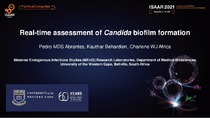Real-time assessment of Candida biofilm formation
Date
2021-09Author
Abrantes, Pedro Miguel dos Santos
Behardien, Kauthar
Africa, Charlene Wilma Joyce
Metadata
Show full item recordAbstract
Background: Candida infections are responsible for increased morbidity and mortality in immunocompromised patients, particularly when the Candida biofilm is composed of drug-resistant species. Although the biofilm formation abilities of individual Candida species have been described, the real-time interactions between common and rarer Candida species are yet to be elucidated.
Methods: In this study an impedance-based biofilm monitoring systemwas used in comparison with the conventional crystal violet (CV) staining method, for demonstrating the biofilm formation of commonly isolated and less common Candida species.
Results: The maximum cell index increased in most mixed biofilms, with the exception of the C. glabrata/C. parapsilosis and C. albicans combinations. Bulk biofilm formation measured by CV stainingwas the highest in C. albicans and C. tropicalis combinations and was the lowest for the C. glabrata/C. parapsilosis combination. Extensive pseudohyphae, which have been associated with increased virulence, were observed in C. albicans and C. glabrata combinations with C. tropicalis or C. parapsilosis.
Conclusion: This study appears to be the first to report on the realtime biofilm interactions of Candida species using the xCELLigence
system and suggests that the presence of specific species influences the biofilm formation of commonly isolated Candida species. This is
important since biofilms act as reservoirs for disseminated infection and as demonstrated in this study, mixed Candida species act in synergy resulting in an increase in biofilm mass and subsequent risk for drug resistance.

